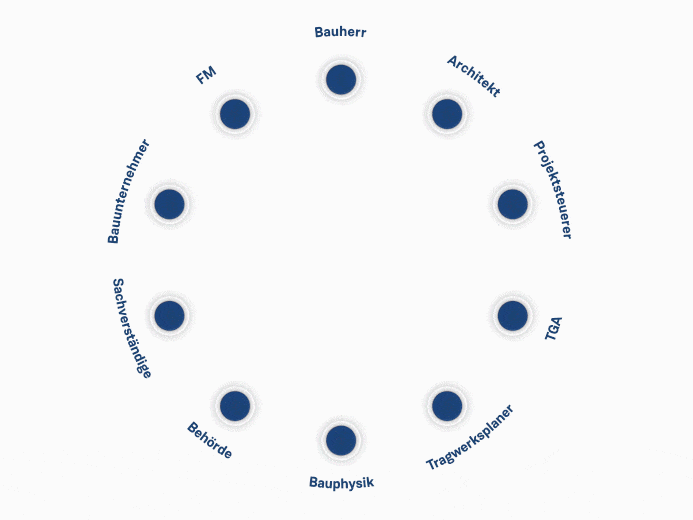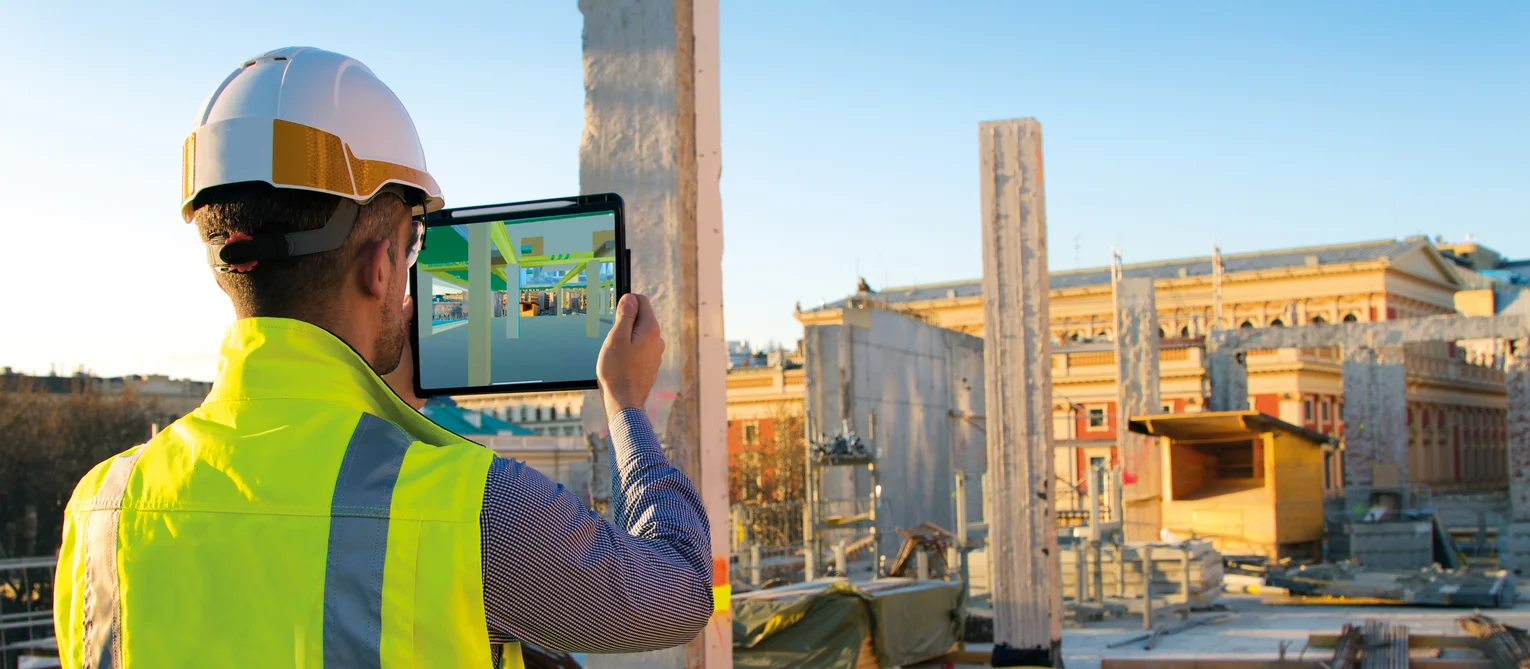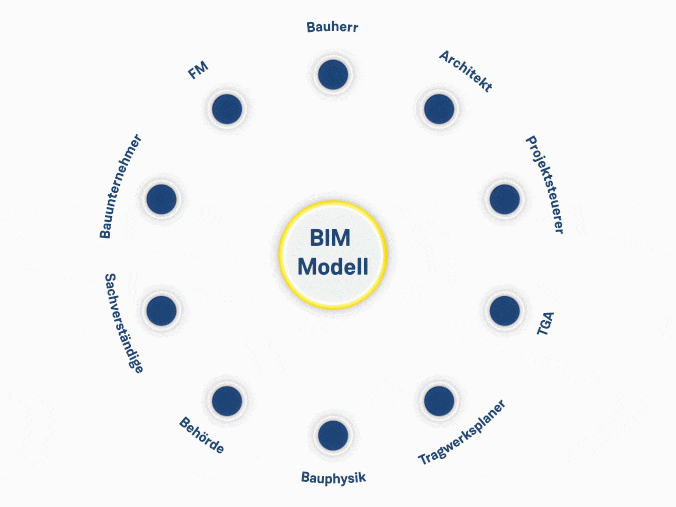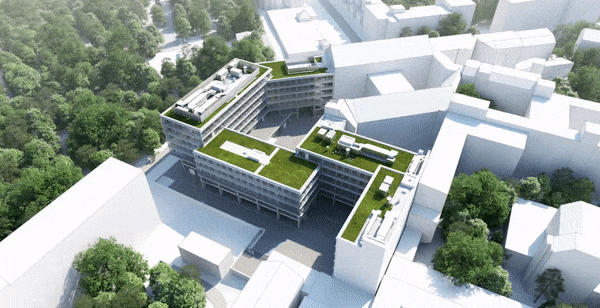
BIM - Building Information ModelingEverything you need to know about the digitalisation of planning and construction
E-mail contact
© PDE
How can we improve cooperation in construction? How can we optimise data consistency in the planning process? Which materials do we need and when? And what impact will a change in plan have on the construction period and costs? A digital way of working offers the answers to these questions: Building Information Modelling, or BIM. PORR is a pioneer in the field and has long recognised the benefits of BIM. We have put together this information to give you an overview and explain the importance of BIM in the digitalisation of planning and construction. Would you like to get in touch with us? You can write to us at bim@porr-group.com.
Building Information Modeling
What is BIM?
Building Information Modelling, or BIM, is an integrative, digital approach to project management in the construction sector. It enables the digital visualisation of all architectural, technical, physical and functional construction data to create an intelligent digital building data model – the BIM model.
Everyone involved in the project can access this BIM model at any time and from anywhere. BIM is not only used in the cost estimation and construction planning phase, it also offers benefits during construction, interior fitting, marketing the property and even in subsequent facility management. It provides a comprehensive overview of almost all phases of the project life cycle.
LEAN Design, LEAN Construction and BIM
Transparency with BIM
Why use BIM?
By using BIM, a building can be modelled in 3D right from the beginning. All of the participants in the project, from the planner and the client to the subcontractor, have access to all information from the start.
They can access the same database from the construction site or in the planning office, which makes working together considerably more transparent and efficient. If changes are made to the plan, the impact on the construction period and costs can be estimated promptly. All of this facilitates communication, simplifies the entire decision-making process and therefore also saves time.
BIM process
Better planning, clearer decisions
Requirement planning, design, tenders and much more: conventional building project management involves many different phases. The different parties involved in the project create a variety of documents at each stage, and all of the drawings, calculations and documents combined show the current status of the project.
Those involved in the project share and coordinate these documents with each other. The slightest change can have a major impact on deadline planning, and on quality and cost calculations. BIM allows these to be visualised and the costs to be examined.
BIM can address all of these challenges. It enables a new method of information exchange between project participants. All of the information can be implemented directly in the central data model, thus avoiding a loss of data, duplicated data and missing communication.


Building information modellingall the benefits at a glance
Faster decision-making
Everyone involved in the project always has the same level of knowledge, so delays are avoided.
Deadline reliability
Fewer supply bottlenecks and less idle time thanks to transparent scheduling.
Efficient cooperation
Everyone involved can work together closely and efficiently, anytime and anywhere.
Improved cost calculation
BIM can simulate the effect that structural optimisations will have on costs.
Avoidance of planning errors
The specialist knowledge of all participants is used to uncover challenges before construction even begins.
Increased quality
Standardised working methods and early recognition of potential enhance quality.
BIM dimensions
Model dimensions at a glance
2D, 3D or even BIM 7D? If we want information about construction costs, we talk about BIM 5D. What is the standard approach in the construction sector and how is building information modelling evolving? A step ahead of the competition, PORR is already laying the foundations for BIM 7D. The terms used provide information on the kind of building model and indicate how many dimensions are considered.
The specific differences are as follows:
- 2D: Conventional CAD planning
- BIM 3D: Creation of 3D building data models using CAD software
- BIM 4D: The additional factor of time is added to the 3D building data model.
- BIM 5D: BIM 3D + time + costs. In addition to the dimension of time, the factor of cost is also added to the building data model. This allows construction progress to be visualised in relation to costs.
- BIM 6D: Physical and thermal parameters are associated with the model. This means that life cycle costs can be analysed and energy consumption can be reduced. The generated data can also be used for building certification.
- BIM 7D: Construction elements are linked with operating information and manufacturer information is added. This means that the models are suitable for facility management and maintenance of the building segments.
In BIM, we also talk about LOD, which stands for Level of Development or Level of Definition and refers to the level of detail of digital building models. The increasing level of information is classified by construction phase on a scale of 100 to 500.
Digital & AgileBIM and LEAN
BIM and LEANthe perfect combination
Good organisation, flexibility and agile methods – new ways of working are needed in the digitalisation of construction processes. As a measure to support project organisation, LEAN Management can help to keep the focus on what is important.
It is not enough just to have a common data model. The aim is to use resources as efficiently as possible and to look at responsibilities, communication channels and processes in advance. BIM and LEAN go hand in hand at PORR – they are part of our company strategy. Cooperation, transparency and communication unite the two approaches and help planners, designers, employers and everyone else involved to work together proactively and efficiently to achieve project success.
Jobs with BIMCareers
Careers in BIM
As new ways of working become established in the construction sector, this also opens up new career opportunities. For example, BIM has created more development opportunities for project managers and estimators, as well as new job roles such as BIM coordinator and BIM manager roles. The aim of these roles is to achieve an improved integrative project process and to promote building information modelling in the company.
Developments in the field of BIM have also opened up new opportunities at PORR. A core team at PORR shares its extensive expertise in building information modelling. On-the-job training contributes to employee training and development and ensures that everyone involved always has the latest information. Do you want to be part of this? Take a look at our current vacancies.
FAQs about building information modelling
References
 Reference
ReferenceVienna Austria
Wien Museum
 Reference
ReferenceSt. Pölten, Austria
Raiffeisen Corner
 Reference
ReferenceInnsbruck, Austria
P2 Innsbruck
 Reference
ReferenceVienna, Austria
Monte Laa - building sites 3 and 5
 Reference
ReferenceVienna, Austria
Berresgasse
 Reference
ReferenceInnsbruck, Austria
PEMA 3
 Reference
ReferenceSalzburg, Austria
BMW Campus
 Reference
ReferenceEbreichsdorf, Austria
TECE Austria
 Reference
ReferenceVienna, Austria
